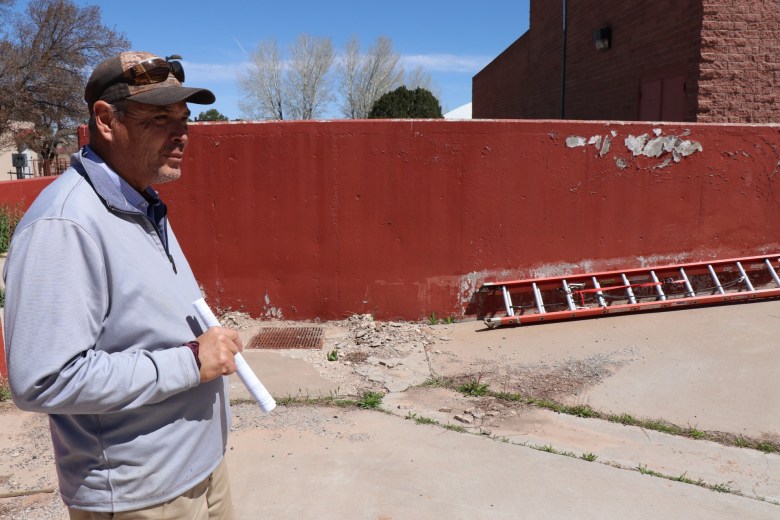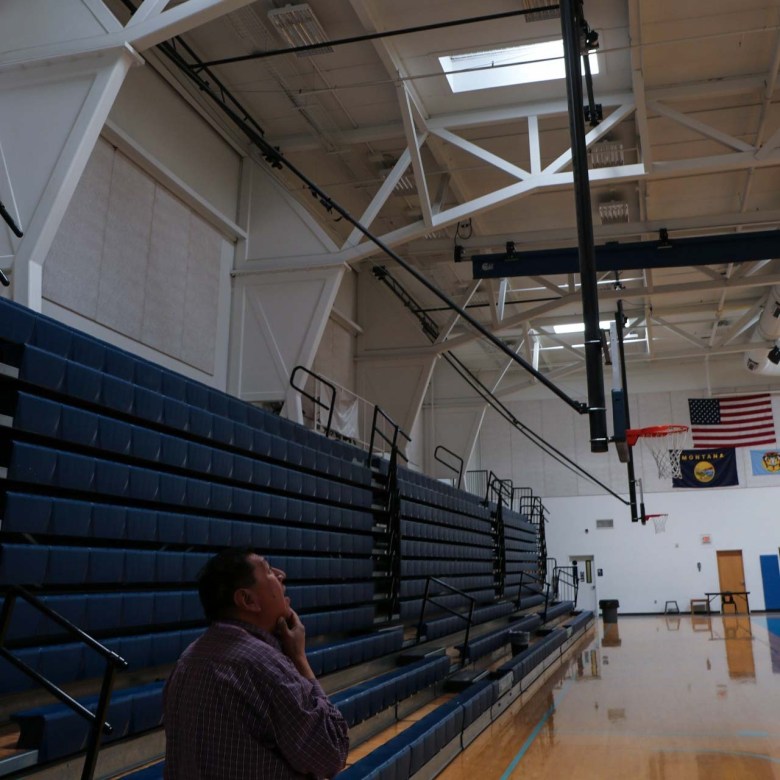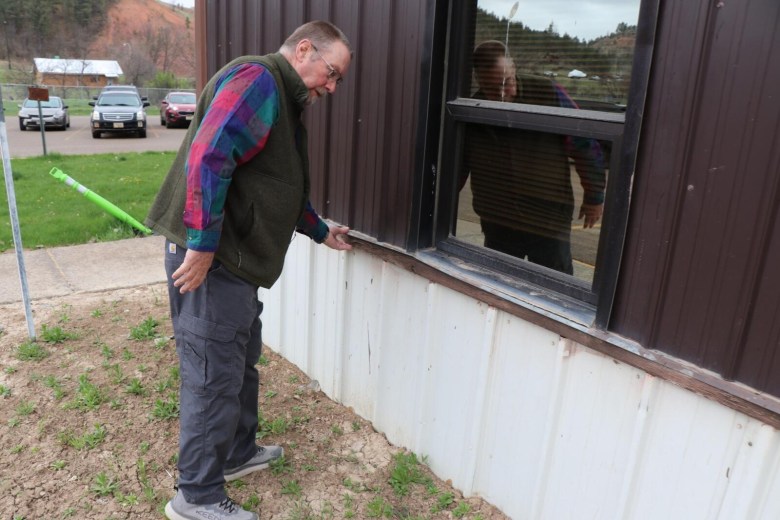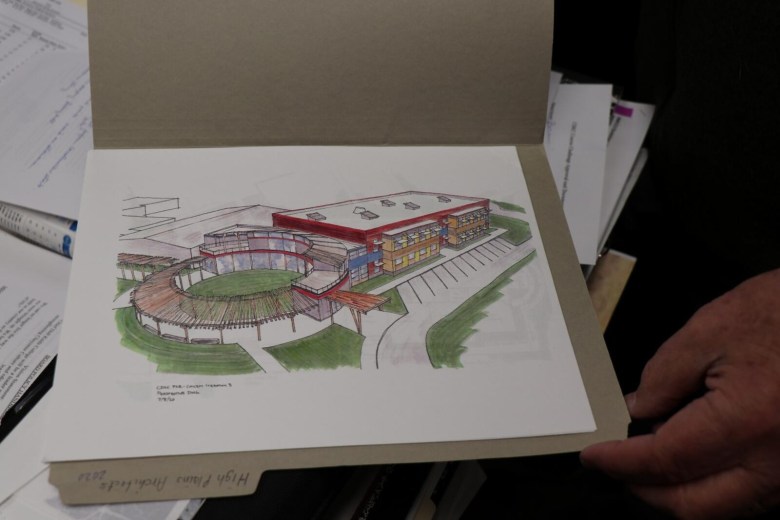ProPublica is a Pulitzer Prize-winning investigative newsroom. Sign up for The Big Story newsletter to receive stories like this one in your inbox.
In the 1970s, Congress committed to funding a higher education system controlled by Indigenous communities. These tribal colleges and universities were intended to serve students who’d been disadvantaged by the nation’s history of violence and racism toward Native Americans, including efforts to eradicate their languages and cultures.

But walking through Little Big Horn College in Montana with Emerson Bull Chief, its dean of academics, showed just how far that idea has to go before becoming a reality. Bull Chief dodged signs warning “Keep out!” as he approached sheets of plastic sealing off the campus day care center. It was late April and the center and nearby cafeteria have been closed since January, when a pipe burst, flooding the building, the oldest at the 44-year-old college. The facilities remained closed into late September.
“Sometimes plants grow along here,” Bull Chief said nonchalantly as he turned down a hallway in the student union building.
While the school appears to be in better condition than most tribal colleges, its roofs leak, sending rain through skylights in the gym and wellness center, which needs $1 million in repairs. An electronic sign marking the entrance has been sitting dark since a vehicle hit it months ago. College leaders said they have no idea when they will be able to afford repairs.
It’s a reality faced by many of the 37 schools in the system, which spans 14 states. Congress today grants the colleges a quarter-billion dollars per year less than the inflation-adjusted amount they should receive, ProPublica found.
President Joe Biden declared early in his term that tribal schools were a priority. Yet the meager funding increases he signed into law have done little to address decades of financial neglect. Further, the federal Bureau of Indian Education, tasked with requesting funding for the institutions, has never asked lawmakers to fully fund the colleges at levels called for in the law.
The outcome is crimped budgets and crumbling buildings in what the U.S. Commission on Civil Rights once called the “most poorly funded institutions of higher education in the country.” At a time when their enrollment is rising, the schools lack money to update academic programs and hire enough qualified instructors to train nurses, teachers and truck drivers and to prepare students to transfer to other universities. As they expand degree programs, their researchers are trying to conduct high-level work in old forts, warehouses and garages.
The laws that authorized the creation of the tribal colleges also guaranteed funding, which was set at $8,000 annually per student affiliated with a tribe, with adjustments for inflation. But the federal government has never funded schools at the level called for in the statute, and even experts struggle to explain the basis for current funding levels.
Since 2010, per-student funding has been as low as $5,235 and sits at just under $8,700 today, according to the American Indian Higher Education Consortium, which lobbies on behalf of the colleges in Washington. Had Congress delivered what’s required by statute, tribal colleges and universities would receive about $40,000 per student today.
The Bureau of Indian Education has not asked Congress for major funding increases for the bulk of the tribal colleges in the past three years, according to the agency’s budget documents, and congressional negotiations have done little to increase what they get.
The Bureau of Indian Education said in a written statement that when requesting funding, it follows guidelines set by the Department of the Interior and the White House. A department spokesperson directed ProPublica to the White House budget office for an explanation of the colleges’ funding; a spokesperson for the budget office declined an interview request and directed ProPublica back to the Interior Department.
Biden called the colleges “integral and essential” to their communities in a 2021 executive order that, among other things, established a tribal college initiative to determine systemic causes of education shortcomings and improve tribal schools and colleges. But while it has led to some forums and largely ceremonial events, that initiative has done next to nothing substantive, advocates say.
As funding has fallen behind the need, even the American Indian Higher Education Consortium — the schools’ primary pipeline to Congress and the Bureau of Indian Education — has asked for far less than the law says the colleges are entitled to. Its recent requests have been for around $11,000 per student.
Some people advocating for the tribal colleges have noted a frequent topic of debate: Should the schools ask for what they’re owed and risk angering lawmakers or just accept the meager amount they receive?

Separately, the colleges get very little for maintenance and capital improvements, money that isn’t part of the per-student funding.
Asked why the Bureau of Indian Education doesn’t better understand the facilities needs at tribal colleges, Sharon Pinto, the agency’s deputy director for school operations, said, “We really wouldn’t know that because the buildings located at these tribal colleges are not necessarily federal assets and they’re not in an inventory system.” In a follow-up email, the bureau said it was waiting for the colleges to let it know what their facility needs are.
Several college leaders and researchers said such responses are typical of a federal government that has routinely ignored its promises to Indigenous communities over the past two centuries.
Meredith McCoy, who is of Turtle Mountain Ojibwe descent and taught at the tribe’s college in North Dakota, noted that Native education is guaranteed by federal law and at least 150 treaties. Neglect of tribal colleges reflects a conscious decision by Congress and the federal government to dodge accountability, said McCoy, now an assistant professor at Carleton College who studies federal funding of tribal schools and colleges.
“The patterns of underfunding are so extreme that it’s hard not to see it as a systematic approach to underfunding Native people,” she said. “We’re teaching our children that it’s OK to make a promise and break it.”
An Outdated System
To evaluate the impact of the federal government’s underfunding of tribal colleges’ and universities’ academic mission, ProPublica sent a survey to the 34 fully accredited schools, of which 13 responded, and visited five campuses. Our reporting found classes being held in a former fort constructed more than a century ago; campuses forced to temporarily close because of electrical, structural and plumbing problems; broken pipes that destroyed equipment and disrupted campus life; and academic leaders who lack the resources to adequately address the issues, build new facilities and keep pace with growing enrollment.
The colleges that responded to the survey reported that they commonly have problems with foundations, roofs, electrical systems and water pipes because they couldn’t afford maintenance. One campus put the price tag for repairs at $100 million. Several noted they don’t have money to upgrade technology so students can keep pace with skills required by the job market.
The Bureau of Indian Education stated in its 2024 budget request that delays in addressing the problems only makes them more costly to fix. Continuing to ignore them could in some cases create “life-threatening situations for school students, staff, and visitors” and “interrupt educational programs for students, or force closure of the school,” the bureau told Congress.
But that same document did not request enough funding to fix the issues, college leaders say.
In 2021, Congress began providing $15 million per year for maintenance, to be shared by all tribal colleges. That has since increased to $16 million — less than $500,000 per college. The same year, the American Indian Higher Education Consortium estimated it would cost nearly half a billion dollars to catch up on deferred maintenance. Construction of new buildings would cost nearly twice that amount. The organization acknowledged the actual price tag could be far higher.

Tribal colleges are not allowed to raise taxes or use bond measures for basic academic or building costs.
The schools receive no federal funding for any non-Native students who attend. Their budgets were stretched even tighter by the COVID-19 pandemic, when non-Native enrollment rose sharply as classes moved online. It has remained above pre-pandemic levels.
The Tribally Controlled Colleges and Universities Assistance Act of 1978, which funded the schools, contributes to confusion over what they should be paid. While it specifies base funding of $8,000 per student, it also notes that colleges will only be given what they need, without explaining how that should be calculated, and only when the government can afford it.
“When we think about the funding, it was set up for something that was needed 40 years ago,” said Ahniwake Rose, the American Indian Higher Education Consortium’s president. “What a school looked like and needed 40 years ago is absolutely not what it looks like and needs now.”
Few Alternatives for Funding
Though colleges and their representatives fault the Bureau of Indian Education, they say primary accountability falls on Congress.
ProPublica contacted 21 members of the U.S. House and Senate who either sit on an appropriations or Indian Affairs committee, or who represent a district or state with a tribal college to ask if they were aware of the condition of the campuses. Only Rep. Teresa Leger Fernández, a New Mexico Democrat, spoke to ProPublica. The others either didn’t respond or declined to be interviewed.
Leger Fernández, a member of the Indian and Insular Affairs subcommittee of the House Committee on Natural Resources, said she has pushed for the colleges to receive more funding but has been shut down by members of both parties, partly because of a lack of understanding about how they are funded.
“Our tribal colleges are part of our federal trust responsibility,” said Leger Fernández, whose district in northern and eastern New Mexico is home to three tribal colleges. “We made a commitment. This is an obligation the federal government has.”
Former U.S. Sen. Ben Nighthorse Campbell, who chaired the Senate Indian Affairs Committee before retiring in 2005, said the colleges lose out to louder voices in Washington, D.C. “Federal money is always caught in a tug-of-war between needs,” Campbell said. “The needs are always higher than the amount available.”
Yet tribal colleges have fewer alternatives for bolstering their budgets.

Many of the colleges are far from industrial centers and have few wealthy alumni, college leaders say, so private donations are rare and usually small.
“We don’t have the alumni who can afford to donate,” said Marilyn Pourier, the development director at South Dakota’s Oglala Lakota College, which is perched on a hill on the Pine Ridge reservation. “We get a pretty good response, but it’s not enough.”
The schools’ tuition is among the lowest in the nation, but college leaders are hesitant to raise it because most reservation residents already can’t afford it.
Naomi Miguel, the executive director of the White House tribal college initiative, said she plans to press states to contribute more to tribal colleges and universities. At the moment, most provide little or nothing.
“If the states would support the TCUs, they’d be supporting jobs in their communities,” said Miguel. “It benefits them overall to create this sustainable workforce.”
“A Saving Grace”
Proof of the value of tribal colleges and universities, advocates say, can be found in what they accomplish despite their meager funding.
Many are the only places teaching their tribes’ languages at a time when nearly all of the 197 Indigenous languages in the United States are endangered.
They are often among the few places in their communities with access to high-speed internet. Nearly 28% of residents of tribal lands lack high-speed internet access, according to the U.S. Department of Agriculture.
And some Native students find that the schools are a more welcoming place to pursue a degree and prepare for a career.
Shyler Martin, who grew up on the Navajo Nation near Navajo Technical University, enrolled there after leaving New Mexico State University during her second year there. Now entering her senior year, Martin said it’s been a relief to learn from instructors who understand the pressures she faces as the oldest child of a Navajo family, with whom she shares responsibility for raising her younger sister.
“They’re culturally sensitive and understanding,” Martin said of Navajo Tech’s staff. “I’m a parent, and they do what they can to help you continue school.”

Yet her time at the college has included winter days when classrooms were so cold that students had to bring blankets and classes that were canceled at the last minute because of a shortage of qualified instructors.
Tribes would be in dire straits without the colleges, said Carmelita Lamb, a professor at the University of Mary in North Dakota who has taught at and studied tribal colleges.
“The tribal college has been a saving grace,” said Lamb, a member of the Lipan Band of Apache. “Had we never had the tribal colleges, I really shudder to think where we’d be now.”
The colleges keep doing the best they can, but some are finding it increasingly difficult.
At Chief Dull Knife, college leaders planned three years ago to build a modern structure with classrooms and a ceremonial arbor, but the estimated price — $14 million at the time — was already out of reach even before it ballooned to more than $20 million because of inflation. The plans haven’t been scrapped, but Bill Briggs, the dean of academic affairs, talks about them in the past tense.
“If we’re going to change the course of this country, everyone needs to have an opportunity,” Briggs said. “All we’re asking for is an opportunity to educate our students.”
This story was produced with support from the Education Writers Association Reporting Fellowship program.



